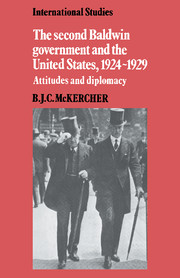Book contents
- Frontmatter
- Contents
- Acknowledgements
- List of abbreviations
- 1 THE SECOND BALDWIN GOVERNMENT AND THE UNITED STATES, NOVEMBER 1924–JUNE 1929
- 2 FOREIGN OFFICE PERCEPTION OF REPUBLICAN FOREIGN POLICY, NOVEMBER 1924–MAY 1927
- 3 THE ONSET OF NAVAL DEADLOCK, JUNE–AUGUST 1927
- 4 BELLIGERENT VERSUS NEUTRAL RIGHTS, AUGUST–DECEMBER 1927
- 5 THE PACT TO RENOUNCE WAR, JANUARY–JULY 1928
- 6 ARBITRATION, BELLIGERENT RIGHTS, AND DISARMAMENT, JANUARY–JULY 1928
- 7 THE CRISIS IN ANGLO-AMERICAN RELATIONS, AUGUST–NOVEMBER 1928
- 8 THE AMERICAN QUESTION RESOLVED, NOVEMBER 1928–JUNE 1929
- Notes
- Bibliography
- Index
3 - THE ONSET OF NAVAL DEADLOCK, JUNE–AUGUST 1927
Published online by Cambridge University Press: 10 November 2009
- Frontmatter
- Contents
- Acknowledgements
- List of abbreviations
- 1 THE SECOND BALDWIN GOVERNMENT AND THE UNITED STATES, NOVEMBER 1924–JUNE 1929
- 2 FOREIGN OFFICE PERCEPTION OF REPUBLICAN FOREIGN POLICY, NOVEMBER 1924–MAY 1927
- 3 THE ONSET OF NAVAL DEADLOCK, JUNE–AUGUST 1927
- 4 BELLIGERENT VERSUS NEUTRAL RIGHTS, AUGUST–DECEMBER 1927
- 5 THE PACT TO RENOUNCE WAR, JANUARY–JULY 1928
- 6 ARBITRATION, BELLIGERENT RIGHTS, AND DISARMAMENT, JANUARY–JULY 1928
- 7 THE CRISIS IN ANGLO-AMERICAN RELATIONS, AUGUST–NOVEMBER 1928
- 8 THE AMERICAN QUESTION RESOLVED, NOVEMBER 1928–JUNE 1929
- Notes
- Bibliography
- Index
Summary
I am troubled about the cruiser question which seems to offer great difficulties. As far as I can make out, we are in the right on the basis of actual needs. America threatens to build for prestige an equal number, though her needs are not equal.
Chamberlain, July 1927The cruiser question
In early 1927 President Coolidge called on the principal naval Powers to meet to complete the work of the Washington conference. At Washington these Powers – Britain, the United States, Japan, France, and Italy – restricted, respectively, the size and numbers of capital ships within a tonnage ratio of 5:5:3:1.75:1.75. Although there had been heated exchanges about cruisers, it proved impossible to include them in the capital ship ratio. All that the delegations could do at Washington was to limit cruiser size to 10,000 tons and armament to eight-inch guns.
Only Britain, the United States, and Japan attended the Coolidge conference, which was held at Geneva between June and August 1927. It was anticipated that an agreement would be arranged to limit cruisers, destroyers, submarines, and auxiliary craft, such as mine-sweepers. The three Powers actually accomplished a great deal. They determined that there was no need to restrict auxiliary craft, and they succeeded in removing problems surrounding the limitation of submarines and destroyers – it was decided that there would be two classes of each type of vessel, squadron leaders and ordinary craft, and the appropriate maxima for each were established.
- Type
- Chapter
- Information
- The Second Baldwin Government and the United States, 1924–1929Attitudes and Diplomacy, pp. 55 - 76Publisher: Cambridge University PressPrint publication year: 1984
- 2
- Cited by



